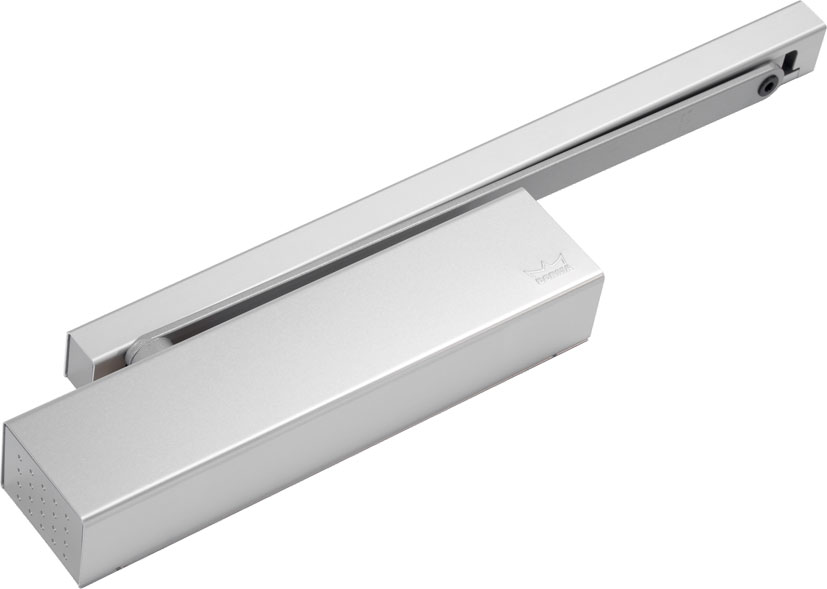As a detrimental component of a fire door’s performance, it is critical to get the specification of fire door closers correct. Here, Graham Hulland, Product Marketing Manager at dormakaba explains the key requirements and outlines the issues to consider to ensure the product is compliant and fit for purpose.
Fire doors are the first line of defence against the spread of smoke and fire, enabling the safe evacuation of all building occupants. As important as the fire door itself is the door hardware and ironmongery.

Fire regulation compliance
Approved Document B of the Building Regulations in England and its equivalent standards in Scotland, Wales and Northern Ireland state that self-closing fire doors should be fitted with a device that is capable of closing the door from any angle against any latch fitted to the door. This device should comply with BS EN1154 for Controlled Door Closing Devices and be CE or UKCA marked to this standard. From January 2023, UKCA will fully replace the CE mark. The product must also have a Declaration of Performance (DoP), which details the characteristics of the product and without which, the CE or UKCA mark is invalid.
Ensuring the product has been successfully tested to this standard is essential as some types of door closer may have ‘fire test evidence’ but not be suitable for self-closing fire doors. This is particularly common where the mechanism relies on dynamic force, such as the momentum of a door closing from fully open, it cannot produce the closing force required to reliably close the door from any angle or hold it shut during a fire.
Furthermore, it is recommended that only door hardware that has been third-party certified is specified for fire doors. Schemes such as BWF-CERTIFIRE provide independent certification of product performance and help ensure the hardware is suitable for the application. It is vital that all hardware fitted to the fire door is third party approved as fitting a non-CERTIFIRE approved component to a CERTIFIRE Certificated fire door may invalidate the certification as a whole.
Furthermore, the ‘scope of approval’ section on the CERTIFIRE test certificate will also help ensure compliance by detailing the product’s suitability for different door types and installation options. For example, the power size of a door closer may differ when installed on the push side of the door as opposed to the pull side.
 Accessibility
Accessibility
Fire doors must also meet accessibility building regulations - Approved Document M in England and Wales, Section 3 in Scotland and Part R in Northern Ireland. These regulations state that “…a door set must produce an opening force of below 30N between 0° and 30° degrees and below 22.5N between 30° and 60° degrees”. Therefore, when selecting a door closer it is important to look at the Torque Curve data provided by the manufacturer, which will show the forces throughout the opening and closing cycle.
Adjustable power door closers are recommended by BS8300, this ensures the minimal opening force can be achieved whilst ensuring full and correct closure of the door, it also allows adjustment to meet other conditions that may be present on site.
Beyond compliance
While ensuring compliance is often the main focus, especially where budgets are restricted, many organisations are now investing in solutions that provide additional safety and convenience for occupants. For example, fire doors are only effective when they are closed but are often propped open because users find the self-closing an inconvenience.
Electromagnetic free-swing and hold open devices offer an alternative approach that meets fire and access requirements and provides ease of movement for residents. Door closers with free-swing functions operate with no resistance during normal use but when the fire alarm is activated, will automatically close the door from wherever the door has been left. Some products, such as dormakaba TS97FLR free swing door closer provide the option to use integrated and additional smoke sensors for activation where an alarm system is not present. Similarly, hold-open devices keep the door fully open and then release the door to close under the power of a standard door closer in the event of fire alarm activation or power failure.
When selecting door closers, it is important to look carefully at the information from manufacturers and third-party certification to ensure the product meets the required standards, is compliant and suitable for the application.
To raise awareness on certification and compliance, dormakaba also provides a watch on demand RIBA accredited animated CPD for Door Hardware on Fire Safety and with a certificate delivered upon completion to earn RIBA points.
Register below to attend this animated RIBA CPD
And to find out more about the dormakaba range of fire door closers and solutions visit the website
- Log in to post comments















